Angela Ackerman's Blog: Writers Helping Writers, page 33
August 28, 2023
Writing About Pain: Describing Minor Injuries
When we push characters to their limits, sometimes they get hurt. Injuries can range from annoyances to mortal wounds, and handled well, can add tension and complication to the story, drawing readers in deeper.
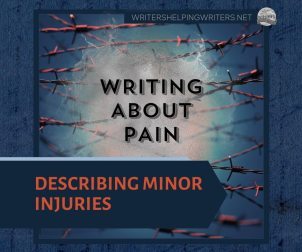
We’re always looking for ways to make sure our characters struggle as they navigate new situations, uncertain environments, dangers and threats. Let’s dive into what minor injuries you might want to inflict that will also bring a dose of authenticity to your fiction.
Common Minor Injuries& How to Describe Them
Superficial cuts and scrapes. These are surface wounds affecting the skin, causing redness, scratches, or shallow wounds. There is a flash of pain, and then blood blooms. You can focus on the redness of the scratches, any dirt or grit caught in the injury, and the searing pain a character will feel when something touches the injured site: a sleeve, branches that slap and scrape as your character navigates a narrow wooded trail, bumping against someone, or even the pain-then-relief sensation when a breeze hits the area.
Bruises. Collisions with hard surfaces or pressure injuries can lead to bruises. Maybe your character was rushing, missed a danger, was careless, or the injury happened through violence. Bruises may throb or ache, especially when the damaged muscle moves. Skin will discolor, turning reddish on a character with lighter skin, or appearing purple, brown, or even black on any with darker skin. Over time, the bruises may turn brown, yellow or even green as they heal before fading completely. With bruising, show a character’s discomfort. They may find it hard to sit or lie comfortably, and wince when the injured muscles move.
Burns and blisters. Exposure to heat or friction can result in burns and blisters, leaving the area tender to the touch. This can make everyday tasks uncomfortable, like having to walk with a blister rubbing the back of a shoe, or having to handle items with a fresh burn on one’s fingers. Blisters appear raised, containing fluid, and burns may also present as blisters or raw skin where several outer layers are removed. Small burns and blisters are easy to forget about until they are bumped or grazed, and then the pain starts anew. If a character has sunburn, their skin will be hot to the touch, red, and pain comes in the form of a radiating heat sensation.

Sprains and strains. Rapid or repetitive movements, twisting, overextending, and otherwise pushing ligaments or muscles too far can lead to stretching or tears that cause pain and limit a character’s range of movement. To describe this, think about the tenderness and painful twinges you feel at these types of injuries, and how your character will have to compensate by limping, hunching over, and moving gingerly. Each bump or unintentional twist can bring about deep pain, so use the character’s face as a map: wincing, drawing their eyebrows low, a pinched mouth. They may suck in a sharp breath through their teeth, or swear under their breath. To find relief, a character may observe the RICE method (Rest, Ice, Compression, Elevation), and use crutches to get around.

Minor fractures or breaks. Most bone breaks are not minor, but a broken toe or finger is usually something you wrap and wait for it to heal. A bone fracture is painful, but isn’t a full break, so healing comes much quicker. In both cases, the character will experience a sharp pain and may ‘feel’ the snap or crack. Anxiety and dread often follows these types of injuries because the character knows whatever they’ve done will need time to heal. These injuries are great when you want to slow your character down, add complication to their life, and limit them in what they can do. When you’re showing this type of injury, think about how your character will overcompensate (limping, shifting their weight, using their ‘good’ hand, etc.) to spare the injured bone. Show their discomfort through pinched facial expressions, a strained voice, a short tempter, or other ‘tells’ that line up with their personality.
Dislocations. When two bones pull away from their natural meeting point, the pain can be excruciating. An unnatural bulge forms where the bone is, causing swelling, intense pain, numbness and tingling. Your character may also feel a rush of fear when their limb suddenly stops working.
In movies, characters often ram the dislocated bone against something to reset it, but unless they’re skilled and experienced, this is dangerous, and causes extreme pain and further injury. So before you decide to have your character do this, ask yourself if they know how or not, or if others are able to assist.
Foreign objects. Splinters, thorns, fishhooks, and other items that pierce the skin can add a dash of authenticity and make your character more irritable, because these everyday annoyances do happen.
Nosebleeds. Maybe someone popped your character in the nose, or they have allergies, the air is dry, or it happens due to another condition or injury. Whatever caused it, nosebleeds are uncomfortable, messy, and can make the character feel embarrassed as they suddenly become the center of attention. To stop the flow, they may pinch the bridge of their nose and tip their head back, but as blood runs down their throat, they may gag in discomfort.

Contact with poison, toxins, or irritants. Some characters have allergies or sensitivities to substances, and coming in contact with these causes an adverse reaction. They may swell up, develop a rash, break out in hives, become feverish, and have trouble swallowing or breathing. This minor situation can escalate into something more dire if they don’t get help.
To describe this injury, focus on the reaction to the toxin as it contacts with the character’s skin. Does it swell up, redden in patches, or feel hot to the touch? If the irritant is something they breathe in, it can cause them to cough, spit, bend over, and wheeze. They may grow anxious if it becomes harder to see or breathe.

Bites and stings. We’ve all gotten too close to a wasp’s nest or been a victim of mosquito bites. The character will feel a small nip of pain at the point of contact, and then the area can swell, itch, and redden. If the character has a sensitivity to the venom or a bite becomes infected, the pain will grow, and the rash will spread.
Minor head or eye injuries. When a character’s head area is injured, they need to take care in case the wound is worse than it seems. Maybe your character bumped their head on a low ceiling beam, had a spark or projectile fly into their eye, became the victim of bear spray, or slipped on ice and hit their head. These injuries can leave them with a throbbing headache, swollen eyelids, blurry vision, and a good dose of panic or worry.
Think Outside the Box When It Comes to InjuriesAs you can see, the ways you can injure characters is only limited by your imagination, so get creative! What might be a fresh way to injure them that makes sense for the action? How can the setting and its inherent dangers be used?
Also, consider your character’s emotional state. Are they rushing to meet a deadline, or feeling panicked because they are out of their depth? When they become injured, do they blame themselves, or feel overwhelmed by their circumstances?
Know Your WhyHurting characters ‘just because’ will lead to flat writing, so have a reason for causing them strife. How will an injury further the story or reveal who they are to readers? Will this new challenge hobble them and force them to think strategically? Are you trying to show their humanity through a response to pain or teach them a lesson for being rash? Know your why so injuries never feel random or contrived.
Also, don’t forget to show the before-during-after awareness chain so your character’s responses are realistic and believable.
In this series:
Writing About Pain: The Three Stages of Awareness
Writing About Pain: Different Types to Expl
ore
The post Writing About Pain: Describing Minor Injuries appeared first on WRITERS HELPING WRITERS��.
August 26, 2023
Character Type & Trope Thesaurus: Doomsday Prepper
In 1959, Carl Jung first popularized the idea of archetypes���”universal images that have existed since the remotest times.” He posited that every person is a blend of these 12 basic personalities. Ever since then, authors have been applying this idea to fictional characters, combining the different archetypes to come up with interesting new versions. The result is a sizable pool of character tropes that we see from one story to another.
Archetypes and tropes are popular storytelling elements because of their familiarity. Upon seeing them, readers know immediately who they’re dealing with and what role the nerd, dark lord, femme fatale, or monster hunter will play. As authors, we need to recognize the commonalities for each trope so we can write them in a recognizable way and create a rudimentary sketch for any character we want to create.
But when it comes to characters, no one wants just a sketch; we want a vibrant and striking cast full of color, depth, and contrast. Diving deeper into character creation is especially important when starting with tropes because the blessing of their familiarity is also a curse; without differentiation, the characters begin to look the same from story to story.
But no more. The Character Type and Trope Thesaurus allows you to outline the foundational elements of each trope while also exploring how to individualize them. In this way, you’ll be able to use historically tried-and-true character types to create a cast for your story that is anything but traditional.
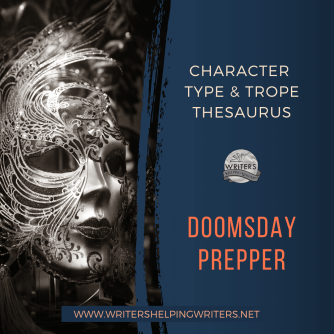 Doomsday Prepper
Doomsday PrepperDESCRIPTION: Paranoid and prepping for the end of the world, doomsday preppers have a very specific skillset, as well as access to resources that are in short supply elsewhere. Their knowledge and assets can be useful in certain scenarios, and these characters often become important contacts for the protagonist, supplying exactly what’s needed in the moment.
FICTIONAL EXAMPLES: Burt and Heather Gummer (Tremors), Hershel Greene (The Walking Dead), Howard Stambler (10 Cloverfield Lane), Dale Gribble (King of the Hill)
COMMON STRENGTHS: Adaptable, Alert, Analytical, Cautious, Focused, Independent, Industrious, Nature-Focused, Observant, Organized, Private, Proactive, Protective, Resourceful, Responsible, Thrifty, Traditional
COMMON WEAKNESSES: Fanatical, Nervous, Obsessive, Paranoid, Pessimistic, Rebellious, Stubborn, Suspicious, Uncooperative, Withdrawn
ASSOCIATED ACTIONS, BEHAVIORS, AND TENDENCIES
Stockpiling resources of food, fuel, weapons, tools, and more
Fortifying their homes or creating bunkers or underground shelters
Being resourceful
Having knowledge of local flora and fauna that could be harvested for food and other needs
Looking out for their family’s interests
Being hard workers
Being skilled marksmen with guns or other weapons
Being alert to potential threats
Distrusting people from certain groups who think differently
Seeking out underground information sources instead of relying on mainstream media channels
SITUATIONS THAT WILL CHALLENGE THEM
Experiencing a disaster they weren’t prepared for
Running out of supplies before the disaster has been resolved
Being ridiculed as paranoid and uncooperative
Being unable to grasp a necessary survival skill, such as growing crops or utilizing solar energy
TWIST THIS TROPE WITH A CHARACTER WHO���
Becomes an unexpected savior in a non-apocalyptic emergency, such as supplying shelter for those in need during a deadly blizzard
Goes from paranoid and fearful to hopeful, trusting, and optimistic through the course of the story
Has an atypical trait: appreciative, generous, scatterbrained, gullible, reckless, etc.
CLICH��S TO BE AWARE OF
The paranoid gun collector with a bunker full of enough food and supplies to last a decade
The conspiracy theorist who adamantly warns people against highly unlikely scenarios instead of preparing for probable disasters
Other Type and Trope Thesaurus entries can be found here.
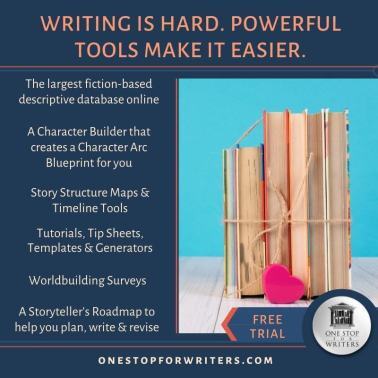 Need More Descriptive Help?
Need More Descriptive Help?While this thesaurus is still being developed, the rest of our descriptive collection (16 unique thesauri and growing) is accessible through the One Stop for Writers THESAURUS database.
If you like, swing by and check out the video walkthrough for this site, and then give our Free Trial a spin.
The post Character Type & Trope Thesaurus: Doomsday Prepper appeared first on WRITERS HELPING WRITERS��.
August 24, 2023
Writing About Pain: Different Types to Explore
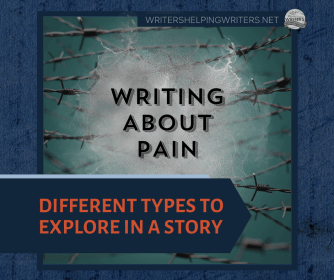
���Life is pain, Highness.��Anyone who says differently is selling something.���
-The Dread Pirate Roberts
Pain is an unfortunate part of life. As our characters go about their day���working, building relationships, pursuing goals and dreams, blowing off steam���things won���t always go as planned, and they will be hurt. When it comes to how quickly and fully they heal, a lot will depend on their pain response. But first we need to know the kind of suffering they���re dealing with.
Kinds of PainMost of us know about physical and emotional pain, but there are more types to consider. And consider them you must if you want to know which makes the most sense for your character in a given scene and in the kind of story you���re writing. So let���s take a look at the categories of pain that are common for all people and are at your disposal for your fictional humans.
Physical PainPut simply, physical pain is the neurological response to bodily harm caused by illness or injury. The severity of this and any other kind of pain will depend on its source. If you step on a LEGO, you’ll feel pain, but the quality, intensity, and length will be different than if you���re catapulted through a windshield during a car crash. The same is true of pain associated with an illness; the discomfort resulting from a sinus infection headache will vary vastly from the pain associated with shingles (as I can unfortunately attest to).
Emotional PainThis can be described as intense and harrowing emotions in the wake of a difficult experience. Divorce, the death of a loved one, victimization, or paralysis in the face of an agonizing decision can all trigger emotional pain in the form of sadness, heartache, grief, self-doubt, or nostalgia. Rather than feeling an ache in our physical bodies, this kind of pain is felt in our emotions. But it���s just as unpleasant as physical discomfort, prompting us to pull away from the source and make the pain stop.
Psychological Pain
Closely related to emotional discomfort, this kind of pain goes deeper, into the realm of mental and emotional suffering. Shame, regret, depression, despair, PTSD, and anxiety are just a few examples. While emotional and psychological pain are similar, a major difference is that while the former tends to be temporary, the latter takes longer to resolve and often requires more dedicated measures, such as therapy or medication.
Social PainSocial pain is a form of emotional pain that results from relational conflict, bullying, social rejection, or being separated from loved ones. It can also be referred to as interpersonal pain because it���s caused by certain interactions with the people around us. This kind of pain can cause the person to feel isolated, excluded, and devalued.
Spiritual PainAs humans, we have physical bodies and emotions, but we���re spiritual beings as well, and negative impacts on the spirit can result in spiritual pain. Situations that threaten a person���s faith, shake their moral code and their ideas about right and wrong, or cause them to doubt their purpose in life can cause spiritual distress.
Chronic PainThis specific form of physical pain is often associated with a chronic illness or injury. It���s defined by its persistence as it carries on for many months or years despite treatment. As such, chronic pain can be especially detrimental, eventually leaching into other areas and spawning emotional, psychological, social, and/or spiritual distress on top of the prolonged physical pain.
Tips for Writing These Categories of PainNow that you���re aware of the different kinds of pain that exist, you can decide what will make the most sense for your character. But there are a few more things to keep in mind if you want to write this universal human experience authentically and believably.
The Pain Types Don���t Always Happen in IsolationStepping on a LEGO, as physically uncomfortable as it may be, isn���t likely to result in other kinds of pain. But more serious situations can result in your character experiencing multiple types of pain at once. Take a physical assault, for example. In the moment, your character will feel pain in their body, but also in their emotions if they struggle with feelings of embarrassment, self-blame, or worthlessness. If the assault occurs in a public place���say, at school���they could experience social pain. If the abuser is a religious figure or mentor, spiritual pain may become a factor, as well.
Whatever���s happening to your character, research those events carefully to understand exactly what they���ll be going through. Then you can focus on the best details from the various categories to show their pain to readers.
Pain Categories Are Often Progressive
A car accident may start with minor physical pain. But what happens when the character discovers that their distracted driving killed someone else? What if the physical discomfort worsens into something chronic?
However the pain begins, the specifics of the root event can determine how it progresses���if it festers or causes other kinds of suffering to develop. Just as many emotions follow a natural progression (from irritation to frustration to anger to rage, for instance), one kind of pain can be followed by another, especially as time passes and the character has time to process what���s happened.
Pain Responses Should Be Tailored to the CharacterResponses to pain will vary from one character to another, depending on a number of considerations. Personality, past experiences, and the character���s current support system are just a few of the factors that will determine how they deal with their pain���if they���re facilitating healing or are responding in a way that���s making things worse. (We���ll look at this more deeply in the 6th post of this series.) The best way to write your character���s pain responses believably is to learn as much as possible about your character so you���ll know how they���re likely to respond.
Put The Emotional Wound Thesaurus to Work
If your character���s pain is coming from a traumatic event, this database at One Stop for Writers may have already done some of the research for you. It covers a variety of wounding events that could have befallen your character, and all the pain categories are covered. (See a complete list here.) So put it to use to brainstorm possible causes for your character���s pain and how they reasonably could respond to it. And for easy reference, you can also find a new tip sheet at One Stop on the different pain categories.
Other Posts in the Writing About Pain SeriesThe Three Stages of Awareness
Coming up: Describing Minor Injuries
The post Writing About Pain: Different Types to Explore appeared first on WRITERS HELPING WRITERS��.
August 22, 2023
Writing About Pain: Three Stages of Awareness
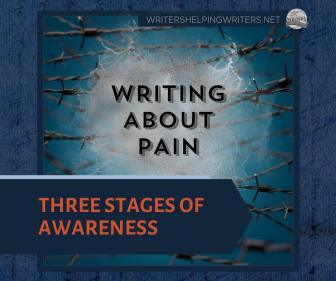
If there’s one thing we like to do as we write, it’s show a character’s pain. Emotional, physical, spiritual, existential…we are all about bringing forth pain and crisis. Is it because we’re a little messed up, and torturing characters is, well, kinda fun? Or do we do conjure painful situations to show the universal truth that life hurts sometimes?
Ah, it’s probably both.
No matter what our reasons for holding our character’s figurative (and possibly literal) feet to the fire, we need to do a bang up job of describing it well. And this is where this series on pain comes in. So join us for a deep dive on all things painful, starting with…
Pain & Your Characters: Three Stages of Awareness Before: Anticipating PainSometimes our characters don’t see a threat coming, but when they do, we gain a terrific opportunity to draw readers into the moment and heighten their emotions alongside the character’s. The anticipation of pain is something we all know, and so it’s an effective way to generate empathy for characters experiencing it.
A character may only have a heartbeat or two to steel themselves: their muscles tense, teeth clamp down, the head draws back, and their eyes shut. To narrow themselves as a target, they might try to make themselves small, a full body cringe. Or they’ll duck, jerk back, pull away, or attempt to flee. This is their instinctual fight-or-flight response, and ultimately they’ll do whatever they believe will protect them (or those they love) in the few seconds they have.

Other times, the threat is farther out, giving the character’s brain time to churn. They have knowledge and experience, and so flashes of what will happen and likely wounds and injuries hit in rapid succession. Memories of past pain assault the character, too, along with the inescapable weight of dread.
Their adrenaline surges, and if they can do anything to escape what’s to come, they do: respond, act, fight, or flee. If there’s nothing they can do, their skin crawls in expectation of the painful sensations to come.
Pain isn’t always physical, of course. If an event is approaching that will hurt your character emotionally, they may fall into a depression or try to avoid it however possible – staying in bed, refusing to go out, avoiding people, staving off the situation by lying, or something else…all things that line up with flight. They could also grow anxious, obsess about what’s going to happen, and force a confrontation before they’re fully prepared to deal with it (fight).
Is the source of pain a secret about to be uncovered? A marriage about to completely unravel? A hospitalized child’s condition degrading? Mental and emotional pain are just as debilitating (or more so) than physical wounds.
TIP: Whatever type of pain your character is experiencing, think about their personality, coping methods, and personal fears. This will help you determine how they will respond to threats that bring pain.
During: Physiological and Psychological ProcessesWhen discomfort happens, it’s felt in different ways. When there’s a physical component, pain receptors pick up on the type of sensory input that’s at work: heat, friction, tension, cold, pressure, etc. and sends signals to the brain about the area affected, the type of pain, and intensity level. The instinctual response is to flee pain, so unless there’s a compelling reason why they must not, a character will seek to pull away and escape. This is especially true when they can see the damage happening (a gash, a broken bone, blood, etc.), and the gravity of what’s happening to them hits home.
Your character’s emotional state will also influence how much pain they feel. If the source of it is tied to a fear, emotionally wounding experience, or their anxiety is triggered, the discomfort they feel is intensified. Other emotions can actually help them weather it better: anger, rage, determination, etc. Pain levels can become so excruciating that a character passes out or enters a state of shock. This is where the body systems slow and they become distanced from their agony.
A character can use coping mechanisms to handle their discomfort, turning to meditation, breathing exercises, self-distraction, talk therapy, etc. or numbing it with medications, drugs, or alcohol. In cases where they are attempting to manage pain through mind over matter, if the threshold reaches a certain point, continued exposure will no longer be possible.
Characters will also experience a stress reaction to pain, meaning their heart rate and blood pressure can rise, their body becomes increasingly tense, their breathing may change and tears may form.
TIP: Using POV visceral sensations to show what they’re experiencing is a great way to communicate the strain they’re under.
After: Recovery and Aftereffects
After an injury or event that causes pain, your character may have a hard time with mobility, balance, and cognitive processing, so keep this in mind when you show readers what happens next. Your character may have to protect the injury, hunching over as they walk, cradling an arm, limping to overcompensate a strained muscle or broken bone. They might have a loss of energy or motor control, have a delayed reaction time, and seek to distance themselves from others so they can process what happened and heal in private.
Everyone copes with pain differently, especially pain that scores an emotional hit. Time will be needed to fully process what happened, and if the emotional hurt is far too painful to examine, characters try to bury it rather than work through it in a healthy way, leading to personality and behavioral shifts that change how they interact with the world and those in it. Unresolved emotional wounds are sources of ongoing pain, so a bit of research here on what this looks like for the type of wound is key.
If your character suffered a physical injury or illness, the healing process can include different types of pain – tenderness, strain, headaches, itchiness, and the like. They may need to rest or sleep more, and if this is impossible because the danger in ongoing, their energy may drain further. It could slow their healing, and open them to infections and more injuries.

After an injury heals, your character may have scars, less range of movement, or suffer debilitating migraines or other internal reactions. Depending on what they experienced, they may also carry new fears, anxieties, a decreased ability to take risks, and even PTSD or other conditions that they will carry with them. Each new encounter with pain will make your character more wary and watchful for any circumstances where it might reoccur, so remember that as they move forward in the story.
Realistic Fiction Sometimes Means Ignoring HollywoodBecause movies only have so much time to show everything they need to, the stages of pain awareness are sometimes skimmed over. Often there’s a split-second awareness of danger and then the camera focuses on the character being injured, whether it’s a gun shot wound to the thigh or a six-pack of punches to the gut. They falter briefly, then rally to win. But when we see them again after the climax, they are usually not as in bad shape as they should be, or are miraculously fine (I’m looking at you, Jack Ryan, and your ability to be perky and ready to go after several rounds of boiling water-and-salt torture!).
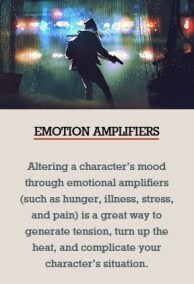
Movies and TV can sometimes get away with this, but books, not so much. Readers want to share the character’s experience, so this means showing things that are true-to-life. You don’t have to go overboard and show every detail, but make sure to convey enough of the before-during-after chain that readers feel the character is responding realistically to pain and injury.
If you need more ideas on how to show pain, this is one of the entries in our Emotion Amplifier Thesaurus.
The post Writing About Pain: Three Stages of Awareness appeared first on WRITERS HELPING WRITERS��.
August 19, 2023
Character Type and Trope Thesaurus: Pessimist
In 1959, Carl Jung first popularized the idea of archetypes���”universal images that have existed since the remotest times.” He posited that every person is a blend of these 12 basic personalities. Ever since then, authors have been applying this idea to fictional characters, combining the different archetypes to come up with interesting new versions. The result is a sizable pool of character tropes that we see from one story to another.
Archetypes and tropes are popular storytelling elements because of their familiarity. Upon seeing them, readers know immediately who they’re dealing with and what role the nerd, dark lord, femme fatale, or monster hunter will play. As authors, we need to recognize the commonalities for each trope so we can write them in a recognizable way and create a rudimentary sketch for any character we want to create.
But when it comes to characters, no one wants just a sketch; we want a vibrant and striking cast full of color, depth, and contrast. Diving deeper into character creation is especially important when starting with tropes because the blessing of their familiarity is also a curse; without differentiation, the characters begin to look the same from story to story.
But no more. The Character Type and Trope Thesaurus allows you to outline the foundational elements of each trope while also exploring how to individualize them. In this way, you’ll be able to use historically tried-and-true character types to create a cast for your story that is anything but traditional.
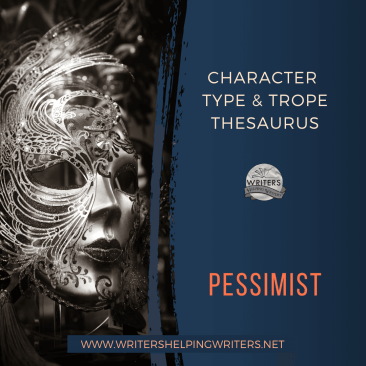 Pessimist
PessimistDESCRIPTION: This doom-and-gloom character believes that if something bad can happen, it will. They tend to focus on flaws and potential pitfalls and see every opportunity as a new way that things can go wrong.
FICTIONAL EXAMPLES: Eeyore (the��Winnie the Pooh��series), Marvin the Paranoid Android (The Hitchhiker’s Guide to the Galaxy), George Costanza (Seinfeld), Sadness (Inside Out)
COMMON STRENGTHS: Alert, Analytical, Focused, Honest, Introverted, Meticulous, Observant, Pensive, Persistent, Resourceful
COMMON WEAKNESSES: Apathetic, Cowardly, Cynical, Fussy, Grumpy, Humorless, Inflexible, Inhibited, Insecure, Lazy, Martyr, Melodramatic, Morbid, Nervous, Obsessive, Paranoid, Pessimistic, Uncooperative, Withdrawn, Worrywart
ASSOCIATED ACTIONS, BEHAVIORS, AND TENDENCIES
Noticing even the smallest details
Identifying problems and risks before they happen
Avoiding potential trouble spots others may not see coming
Being cautious
Easily identifying things that need improvement
Planning ahead
Being thorough
Always seeing the glass as half empty
Frequently frustrating others with their constant negativity
Having only a small circle of friends
SITUATIONS THAT WILL CHALLENGE THEM
Having to share space with an extreme optimist
Facing a situation with unknown factors they haven’t had time to prepare for
Being complimented for their skills or abilities
TWIST THIS TROPE WITH A CHARACTER WHO���
Is empathetic and insightful, supporting others during the crisis the character was able to prepare for
Has a witty and dark sense of humor (instead of just being annoying)
Has an atypical trait: affectionate, confrontational, persuasive, vain, workaholic, etc.
CLICH��S TO BE AWARE OF
The team member who rains on everyone’s parade, creating a perpetually gloomy atmosphere
The cynical best friend who always prophesies doom (and turns out to be right)
Other Type and Trope Thesaurus entries can be found here.
 Need More Descriptive Help?
Need More Descriptive Help?While this thesaurus is still being developed, the rest of our descriptive collection (16 unique thesauri and growing) is accessible through the One Stop for Writers THESAURUS database.
If you like, swing by and check out the video walkthrough for this site, and then give our Free Trial a spin.
The post Character Type and Trope Thesaurus: Pessimist appeared first on WRITERS HELPING WRITERS��.
August 16, 2023
Phenomenal First Pages Contest – Guest Editor Edition
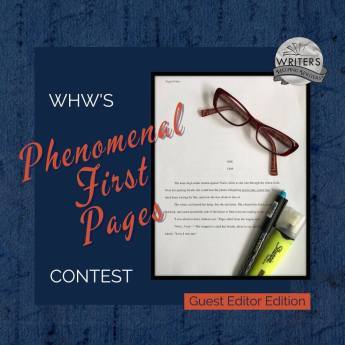 Hey, wonderful writerly people! It���s time for our monthly critique contest! This month, winners will receive feedback from a professional editor. So exciting!
Hey, wonderful writerly people! It���s time for our monthly critique contest! This month, winners will receive feedback from a professional editor. So exciting!  Eight winners will receive a critique of their first five pages.
Eight winners will receive a critique of their first five pages. If you���re working on a manuscript and would like some objective feedback, please leave a comment. Any comment :). As long as the email address associated with your WordPress account/comment profile is up-to-date, I���ll be able to contact you if you’re chosen. Please know that if I���m unable to get in touch with you through that address, you���ll have to forfeit your win.
Here’s the editor you’ll be working with:Erica Converso
I���m Erica Converso, author of the Five Stones Pentalogy (affiliate link). I love chocolate, animals, anime, musicals, and lots and lots of books – though not necessarily in that order. In addition to my work as an author, I have been an intern at Marvel Comics, a college essay tutor, and a database and emerging technologies librarian. Between helping adult patrons in the reference section and mentoring teens in the evening reading programs, I was also the resident research expert for anyone requiring more in-depth information for a project.

As an editor, I aim to improve and polish your work to a professional level, while also teaching you to hone your craft and learn from previous mistakes. With every piece I edit, I see the author as both client and student. I believe that every manuscript presents an opportunity to grow as a writer, and a good editor should teach you about your strengths and weaknesses so that you can return to your writing more confident in your skills. Visit my website astrioncreative.com for more information on my books and editing and coaching services.
Contest GuidelinesThis month���s contest will work the same as it usually does���except our amazing guest editor will send feedback if you win.Please be sure your first five pages (double-spaced in 12-point font) are ready to go so our guest editor can critique it before next month���s contest rolls around. If it needs some work and you won���t be able to get it to me right away, please plan on entering the next contest, once any necessary tweaking has been taken care of. This contest only runs for 24 hours, start to finish, so get your comment in there!Eight commenters��� names will be randomly drawn and posted tomorrow morning. If you win, I’ll contact you with information about sending it to me. Then, I’ll forward it to our amazing editor for feedback.
We run this contest on a monthly basis, so if you���d like to be notified when the next opportunity comes around, consider subscribing to our blog (see the right-hand sidebar).
Good luck! I can’t wait to see who the winners will be. 
 Want to give your writing a boost?
Want to give your writing a boost? Join Resident Writing Coach Suzy Vadori for a 3 day virtual Writer’s Retreat this fall to get unstuck in your writing process, get inspired, and ask all the questions you’ve ever had about writing a book. See you there!
The post Phenomenal First Pages Contest – Guest Editor Edition appeared first on WRITERS HELPING WRITERS��.
August 15, 2023
How Do You Find Your Narrator���s Voice?

Voice is one of those elements that can make or break a manuscript. If you get it right, the novel will live in the reader���s mind long after they put the book down. Without it, the story won���t quite achieve what you���ve intended even if all the structural elements are in place.
So��� how do you find your narrator���s voice?
What Doesn���t WorkHere���s one thing that doesn���t work: verbal tics. How many times can you have your character repeat certain phrases before it starts to get, well, annoying? Not very many.
Here���s another: sarcasm.
Sarcasm is an easy voice to capture, so it seems to be the one many authors lean toward to make their narrator sound different. Cross it off the list. No one is consistently sarcastic, or angry, or melodramatic. When you make your narrator into a type like this, they come across as one-dimensional and unrealistic.
Who Is This Person?The idea of voice only being a mood or a way of talking misses the bigger picture. Voice is a way of being in the world. For that reason, I would recommend approaching it from another direction: by exploring who this person is that you���re trying to bring to life.
While I don���t think character questionnaires are the way to nail voice, they can be a good steppingstone in getting to know your character���because I don���t think you can capture a character���s voice until you fully know who they are.
Look at how the answers to a few key questions can change the type of person you���re dealing with.
What does your character do for a living?

A baker will have a different way of viewing the world than a plumber or a doctor. They���ll notice different things, use their own analogies, have unique priorities, behave differently in various situations. You���ll know they���re a baker not because the author has placed them in a kitchen wearing oven mitts but because they see ideas for new pastries in the shapes of flowers. They���ll think like a baker.
If you were to read a story in which all you got was oven mitts and cookie trays, you���d feel like you were reading something generic���because the author would not have captured a baker���s way of navigating the world.
How old is your character? What is their marital status?
A twenty-something single woman will have a different way of dealing with people than a fifty-something woman who���s just left a long, dull marriage. Or maybe the marriage was abusive: that would give her another voice. Or maybe she���s never been married, but her sister is in a happy marriage: different voice again. She���ll have to manage Valentine���s Day; she might get upset by seeing couples at candlelit tables for two in a restaurant.

Voice is all about the lens through which your character views the world. One of the most significant things that clarifies this lens is their goal: what do they want in the story? If someone wants respect, they���re going to act in certain ways and say certain things that will be very different from someone who���s out for revenge.
Where do they come from? What kind of family do they have? Wealthy or poor, loving or abusive? Are they the first-born of a large family, or are they the baby? Are they an only child?
Every answer creates a type of person who will act and react in diverse ways. Many of these actions and reactions won���t be conscious, but they���ll be there, and they���ll cement in place patterns of behavior that will (hopefully) cause that character all sorts of problems.
But answering those questions is only step one.
What Next?Now, you have to put your characters into action: slip on their shoes and see the world through their eyes. Usually that means writing your way into the story in one form or another: by journaling in their voice, answering interview questions in their voice, or (my preference) simply throwing yourself into the story world and getting them moving.
This is why it���s so important to differentiate the narrative voice from the author���s voice. Unless the author is the narrator, they have no business speaking up. Your reader will have picked up a particular book to experience the world from the point of view of a female scientist in the 1960s (Lessons in Chemistry) or a college student in the classics who becomes enthralled with an eclectic group of students with whom he doesn���t quite fit in (The Secret History). The extent to which the author can deliver on that promise also turns out to be the extent to which they���ve captured the narrator���s way of seeing the world, which is��� voice.
Why Voice Is So ImportantVoice is not the only thing in a novel. But if you don���t nail it, you won���t have used point of view to its fullest potential, nor will you truly know your story���because you won���t know the main actors who are driving it forward. It won���t feel authentic, and your readers won���t feel the same emotional draw that they���ll experience when a character comes to life on the page and says, Let me show you what the world looks like through my eyes.
Isn���t that why we come to fiction in the first place?
The post How Do You Find Your Narrator���s Voice? appeared first on WRITERS HELPING WRITERS��.
August 12, 2023
Character Type and Trope Thesaurus: Mad Scientist
In 1959, Carl Jung first popularized the idea of archetypes���”universal images that have existed since the remotest times.” He posited that every person is a blend of these 12 basic personalities. Ever since then, authors have been applying this idea to fictional characters, combining the different archetypes to come up with interesting new versions. The result is a sizable pool of character tropes that we see from one story to another.
Archetypes and tropes are popular storytelling elements because of their familiarity. Upon seeing them, readers know immediately who they’re dealing with and what role the nerd, dark lord, femme fatale, or monster hunter will play. As authors, we need to recognize the commonalities for each trope so we can write them in a recognizable way and create a rudimentary sketch for any character we want to create.
But when it comes to characters, no one wants just a sketch; we want a vibrant and striking cast full of color, depth, and contrast. Diving deeper into character creation is especially important when starting with tropes because the blessing of their familiarity is also a curse; without differentiation, the characters begin to look the same from story to story.
But no more. The Character Type and Trope Thesaurus allows you to outline the foundational elements of each trope while also exploring how to individualize them. In this way, you’ll be able to use historically tried-and-true character types to create a cast for your story that is anything but traditional.
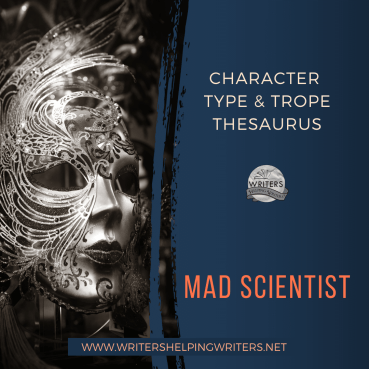 Mad Scientist
Mad ScientistDESCRIPTION: Brilliant, eccentric, and often insane, the mad scientist believes his work is vitally important and supersedes conventional morals or ethics.
FICTIONAL EXAMPLES: Dr. Moreau (The Island of Dr. Moreau), Dr. Frankenstein (Frankenstein), Dr. Jekyll (The Strange Case of Dr. Jekyll and Mr. Hyde), Doc Brown (Back to the Future), Walter White (Breaking Bad)
COMMON STRENGTHS: Ambitious, Analytical, Creative, Curious, Disciplined, Focused, Idealistic, Independent, Industrious, Intelligent, Introverted, Meticulous, Observant, Passionate, Pensive, Perceptive, Persistent, Quirky, Talented
COMMON WEAKNESSES: Antisocial, Fanatical, Impatient, Impulsive, Irresponsible, Obsessive, Reckless, Stubborn, Unethical, Workaholic
ASSOCIATED ACTIONS, BEHAVIORS, AND TENDENCIES
Perfectionism
Having eccentric habits
Obsessing over their work
Keeping odd hours
Working in long binges
Preferring to work alone
Difficulty engaging in small talk and other social niceties
Rejecting (or ignoring) those in authority
Forgetting to do basic life tasks, like cooking, cleaning, grooming, and sleeping
Their goals or methods putting them at odds with the establishment
SITUATIONS THAT WILL CHALLENGE THEM
An experiment creating unexpected (and bad) results
Being forced to work with a strict rule-follower
A “hack” achieving success and finding acclaim ahead of the scientist
Being prevented from doing the work they dream of
TWIST THIS TROPE WITH A CHARACTER WHO���
Isn’t male
Is concerned with ethics and the consequences of their work
Is an amateur scientist (rather than a professional one) who’s passion is using science to create crazy stuff
Has an atypical trait: flirtatious, humble, optimistic, superstitious, proper, etc.
CLICH��S TO BE AWARE OF
The mad scientist with crazy hair and no fashion sense
The scientist who creates a creature or monster they can’t control, and it ends up destroying them
A scientist with multiple personalities
Other Type and Trope Thesaurus entries can be found here.
 Need More Descriptive Help?
Need More Descriptive Help?While this thesaurus is still being developed, the rest of our descriptive collection (16 unique thesauri and growing) is accessible through the One Stop for Writers THESAURUS database.
If you like, swing by and check out the video walkthrough for this site, and then give our Free Trial a spin.
The post Character Type and Trope Thesaurus: Mad Scientist appeared first on WRITERS HELPING WRITERS��.
August 10, 2023
Powering Through the Un-Fun Parts of the Job

I���m gonna go out on a limb and say you probably became a writer because you like to write. But if you���ve been writing for any time at all, you may have realized that writing isn���t the whole job. There are lots of other things you have to do that you maybe aren���t good at, don���t like, or even dread doing. We���re often the most inefficient when it comes to those responsibilities because we avoid them or rush through them to get them over with. And this impedes our progress and our ability to do our best work.
Personally, I find the screaming goat super helpful for stress relief during frustrating or boring tasks.

But, alas, not everyone has one. So I���d like to share some strategies you can implement to ensure even the irritating parts of the job get done efficiently. Because we’re all wired differently, some of these ideas may be harder for certain kinds of people, so let’s look at how to make them work for everyone.
Strategy #1: Outsource the Tough or Tedious JobsThis one is easy: pay someone to do the dirty work so you can focus on the things you like to do. Hate balancing the checkbook? Hire a bookkeeper. Do you suck at book formatting? There are freelancers who will do this for a fee. So if you have the funds, this may be the easiest way to claw back your own time and use it on the things you do best. (If you’re looking for a freelancer, we’ve got a list of recommendations here.)
Personality Blockers: Control Freaks, Perfectionists, and Penny PinchersWhen it comes to outsourcing, the biggest obstacle is simply not having the cash. That���s a legitimate blocker for everyone, regardless of personality. However, there are writers who can afford the expense, but they still resist sharing the load. Some are maybe a bit too thrifty; they���ve got the money, but they’re worried about spending it. Others are afraid to give up control of any part of their project���often because they want it done just so and they can���t trust others with their baby. If any of these personality traits apply to you, outsourcing could be difficult to embrace.
The solution here is to recognize that offloading those tasks can increase your efficiency, resulting in more time and, ideally, more money. Angela and I, because we’re problem children, had to learn this the hard way. For years, we wanted to hire someone to take over the administration of our blog���not because we didn���t enjoy fielding guest post requests, talking to potential contributors, and scheduling posts; we just didn���t have enough time to do everything that needed doing. And because we were so swamped, we didn���t want to spend our precious time on hiring someone. Finally, we just bit the bullet and brought on our blog wizard, Mindy, and suddenly we had a surplus of time to devote to other projects���things that, really, only Angela and I could do.
If you’re able to outsource but are holding back, consider how much more productive you could be if someone else were doing the things you were least proficient at. Just opening up to the possibility can help you loosen the reins or the purse strings enough to pass off some of those duties, saving you buckets of time that can be spent on the stuff you���re really good at.
Strategy #2: Identify the Hard StuffOk, so this seems pretty obvious, but we���re all really good at focusing on what we like and ignoring what we don���t. This results in the boring jobs either getting pushed to the last minute (and not being done well) or not getting done at all. Making note of the things you don���t enjoy doing���the things that maybe you���re doing halfway because you dislike them so much���is the first step in prioritizing them properly so they don���t get left behind.
Personality Blocker: AvoidersThis is a tough one for avoiders who tend to ignore the unpleasant, uncomfortable, or awkward. If avoidance is an issue, hit this head-on and set aside a quick 15 minutes to make a list of the parts of your job you tend to put off or ignore. It might be easier to keep an ongoing list and add to it over time as things occur to you. These difficult duties will differ from person to person, so identify what they are for you and make yourself aware of them.
Strategy #3: Schedule the Hard StuffOnce you���ve identified the problem areas, set a deadline for when each one needs to be completed. Then add them to your weekly or monthly schedule so they don���t get forgotten.
Personality Blocker: ProcrastinatorsProcrastinators commonly put off unwanted responsibilities until the very last minute (or indefinitely). If this is you, it���s important to get those duties on the schedule. But you may not be as efficient if they’re scheduled up front, ahead of the jobs that are a bit more rewarding. If this is you, it’s ok to compromise. Schedule the dreaded tasks somewhere in the middle, after you���ve finished some of the fun stuff (but not jammed up against your deadline).
For more information on my favorite tool for planning and scheduling tasks, see this post on Trello.
Strategy #4: Break It UpSome jobs are unpleasant because of the sheer amount of time they take. One way to make a task like that more palatable is to break it into smaller chunks and complete it over a series of work sessions.
Personality Blocker: All-At-Once’ersThis strategy used to be hard for me because I���m motivated by finishing things; I need a sense of completion, and this drives me to compartmentalize my workday and just hammer away at one project at a time until it���s done.
One of my regular responsibilities is to take the thesaurus posts we���ve published at Writers Helping Writers and move them over to our One Stop for Writers site. This involves a lot of cutting and pasting, HTML stripping, and adding additional content. It���s not the most stimulating work, and when you���re looking at 50 or so entries, it seems to take forever. So instead of trying to do it all at once���say, taking a week and focusing just on that job���I do one or two entries a day. Then I can spend the rest of my time doing other things that are more rewarding. This requires some careful scheduling to make sure I start the job early enough to hit my deadline, but it makes it more doable. It’s a great strategy to employ with long projects, such as editing a novel.
Strategy #5: Make It FunFull disclosure: there’s only so much you can do to make analyzing sales data or writing a summary for your story fun. But you can make most jobs more enjoyable. Here are some ideas that work for me:
Break out the ���happy��� supplies, like a favorite pen, notebook, or plannerLight a specific scented candle that���s only used when you really need a kick in the pantsWork in a new spot, such as a coffee shop, the park, or the library, until the job is doneOutfit your own workspace with things that makes you smile: inspirational notes, pictures of loved ones, knickknacks that hold special meaning, etc.Put on fun or motivational musicEat or drink something yummy Becca’s collection of stuff her kids have madePersonality Blocker: Being Easily Distracted
Becca’s collection of stuff her kids have madePersonality Blocker: Being Easily DistractedOne potential issue with this strategy is if you end up wasting precious work time mooning over knickknacks or looking for your special highlighter when you should be working. If you struggle with this, put a limit on how many feel-good items are allowed in your workspace. And if you find yourself using this prep time as an excuse to procrastinate, set a time limit for how long you’ll allow yourself to get prepared before getting to work.
Strategy #6: Reward YourselfAnd now for the good stuff! The best way to motivate yourself to do a hard job is with a reward. Once the dirty work is done, get your favorite Starbucks drink, head to the beach at sunset, buy those shoes you���ve been eyeing, or knock off a half-hour early for some pleasure reading. The dangling carrot works well for pretty much everyone; you���ll just need to establish the reward for each project ahead of time so you know what you���re working toward.
 My favorite pink drink!Personality Blocker: Over-Indulgers
My favorite pink drink!Personality Blocker: Over-IndulgersIf each chapter you draft results in a day off, you���re not going to get much done. Remember that efficiency and productivity are the goals, so make sure the reward matches the job.
Strategy: Shift Your MindsetThis is maybe the simplest strategy to make the hard jobs easier, and it has no personality blockers because it can work for literally everyone. Viewing certain jobs as hard, boring, tedious, or a waste of time will ensure that you put them off, rush through them, or don���t give them your best effort. Instead, shift to a productive inner voice by looking at those duties through a positive lens:
This is important work.I can do this.I���m better at this than I used to be.Once I’ve mastered this, I’ll have something new to add to my skillset.I���m saving money by doing this myself.This job isn���t going to take as much time as I thought.The time (or money) I���m spending on this task is an investment into my business.Every difficult or undesirable job has its silver lining. Looking at the bright side can change your attitude so you give it your full attention and effort, resulting in a job well done.
The post Powering Through the Un-Fun Parts of the Job appeared first on WRITERS HELPING WRITERS��.
August 8, 2023
The Secret to Writing Your First Book Faster

It took me two and a half years to write and revise my first book to get it to the point it was ready for readers. And then another 2 years to find my publisher and get it out into the world. My next book I wrote in 6 months. I now coach other writers, and I see this pattern of book 2 getting written much faster over and over again. Seems obvious, right?
Well, yes, but not for the reasons you may think. Sure, by your second book, you���ve honed your technique and have developed some (hopefully!) good writing habits. But that���s not it.
Writers��� blogs and forums are riddled with advice for you to write faster, everything from getting your word count in daily, to using templates or formulas to fill in your structure. And following this advice may indeed make writing your first draft faster. But your first draft isn���t the finished product, as much as you may want it to be.
The time between completing a draft and knowing that a manuscript is everything you���d hoped it would be is this murky space few writers talk about, where especially newer writers get lost, losing weeks, months, or years sitting in a doubtful limbo.
Writing a first draft is a huge accomplishment, don���t get me wrong. But you���ll know in your heart it isn���t ready for prime time. The idea of revisions can be daunting. Overwhelming, even.
When I found myself in this unexpected murky place when I was writing my first book more than a decade ago, I had questions like:I���m being told my book ���isn���t ready��� yet by agents, editors, and publishers. But how do I know what to work on? Should this be obvious to me?Some of my favorite writers write books in 3 months or faster. Why can���t I seem to do this?My gut is telling me I need to rip the whole book apart and then put it back together again to make it what I want. Do I REALLY have to do that?If my draft isn���t perfect, does this mean I don���t have what it takes to be a writer??Am I really good enough?Ugh.

And so, I spun my wheels, and looked for answers. Everything I���d dreamed writing a book would be like was kinda shiny. In my ideal world, words would flow, and accolades would follow. None of the writers I followed glorified the thousands of hours it might take, the deep focus I���d have to learn, or the number of times I might have to tweak my scenes until I got all my ideas on the page the way I wanted them.
I chipped away at what I knew in my heart needed to get done, piece by piece, because I was determined that my book wouldn���t see the light of day until it was ready. The only way to get my messy first draft in shape was to push through, and do the work, as much as I wanted to find a shortcut. I honed my craft. I took courses and workshops. I sought out the best editors I could find, and learned. I was, and still am, immensely proud of that book, which went on to sell thousands of copies and win awards. Most importantly, I heard from my tween and teen readers that the book affected them. That they shared it with their friends. That���s all I ever wanted.
When I sat down to write Book 2 in that series, I assumed it would be much faster. After all, I���d already created the world and its characters. It was going to be a breeze.
But I was wrong.
Because I���d already created the world and its characters, I found I needed much more content for Book 2 than I expected. Huh. So, how did I still write that book muuuuuch faster? This is the secret sauce I wish every first time author could know��� and I���ve since dedicated my book coaching practice to help writers get through that murky middle time.

By the time I got to writing book 2, I understood in my bones just how much work I was going to have to put into this book to make it exactly what I wanted. I didn���t look for shortcuts, or worry that I wasn���t a good writer because I couldn���t do it ���faster���. I didn���t wonder if I was doing it wrong. I just put down one word at a time, and then tackled one revision task at a time, until it was done. I was able to cut out the murky, wallowing phase that eats up so much time.
I now work with writers on first books all the time. And if there���s one thing I always want to share with them, it���s that all the work has to get done. No beta reader, editor, or publisher is going to do it for you. So, plan for it, and chip away at it until your book is exactly what you want it to be.
So, if you���re writing your first book, keep going and you���ll get there. If you���ve completed a draft, and are stuck in the resistance phase in the murk, here���s some next steps you can take to keep your book moving forward. Once you know what needs to get done, knock off one step at a time until you���ve got a book you���re proud of.
But don���t stop moving, or you���ll land in the time-sucking murk.
Do what you can to skip over the part where you doubt if you���re doing it right, and dive in with full gusto.
Once you���ve written your first book, and gone through this path of resistance, coming out with a book ready to publish on the other side, I���d put money on the fact that you���ll get to the end of your second book��� and that you���ll write it faster than you did your first.
The post The Secret to Writing Your First Book Faster appeared first on WRITERS HELPING WRITERS��.
Writers Helping Writers
- Angela Ackerman's profile
- 1022 followers



